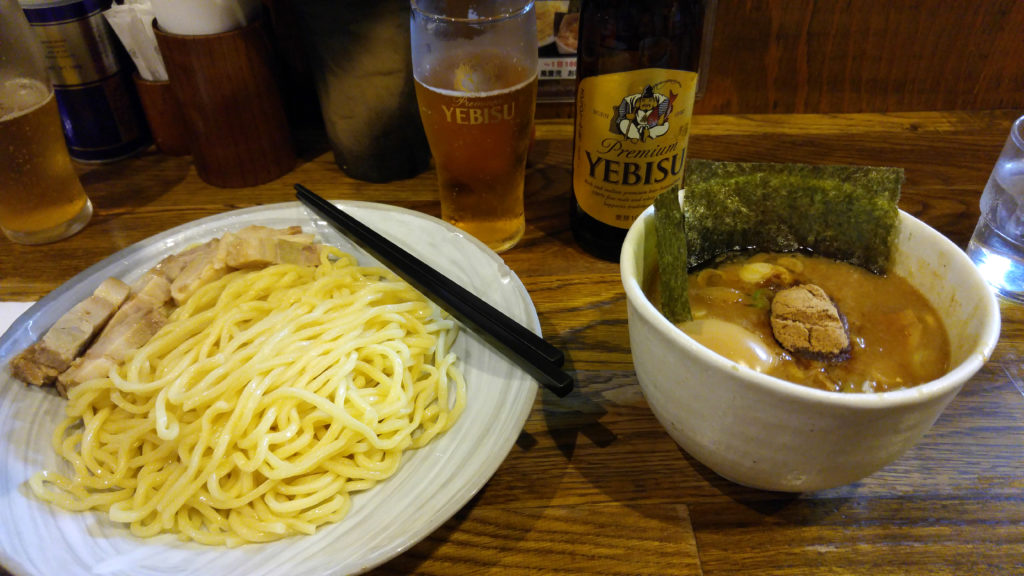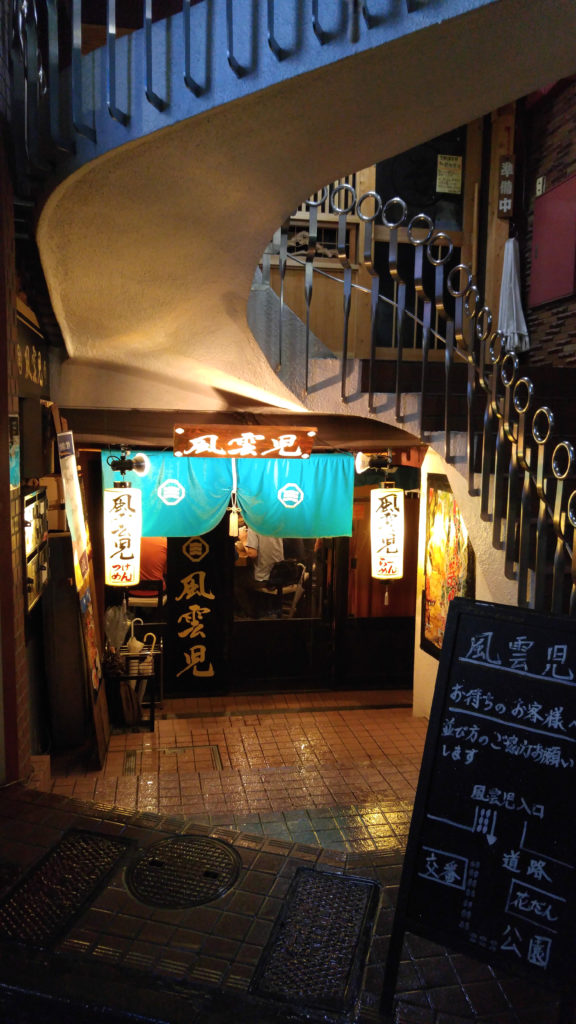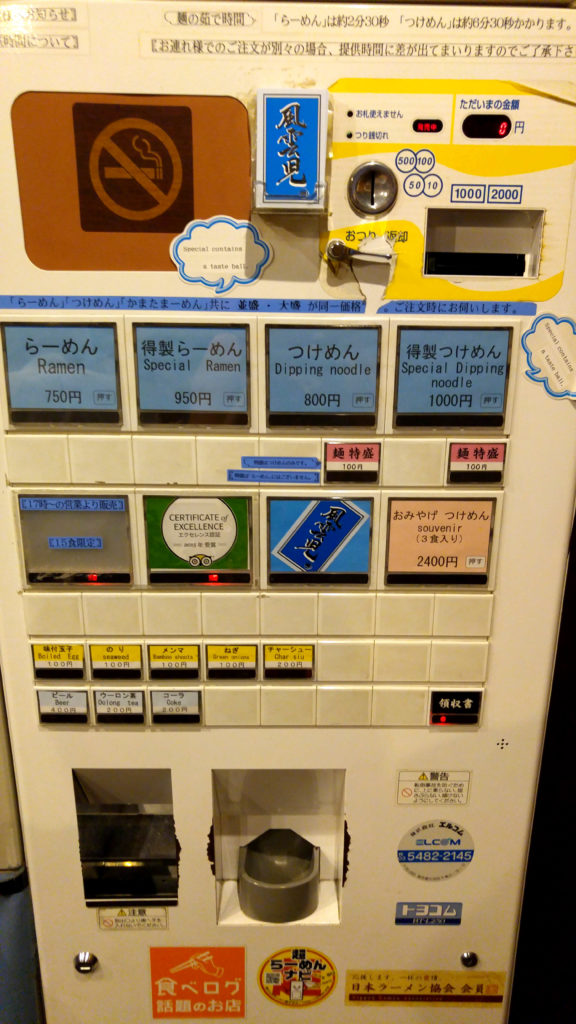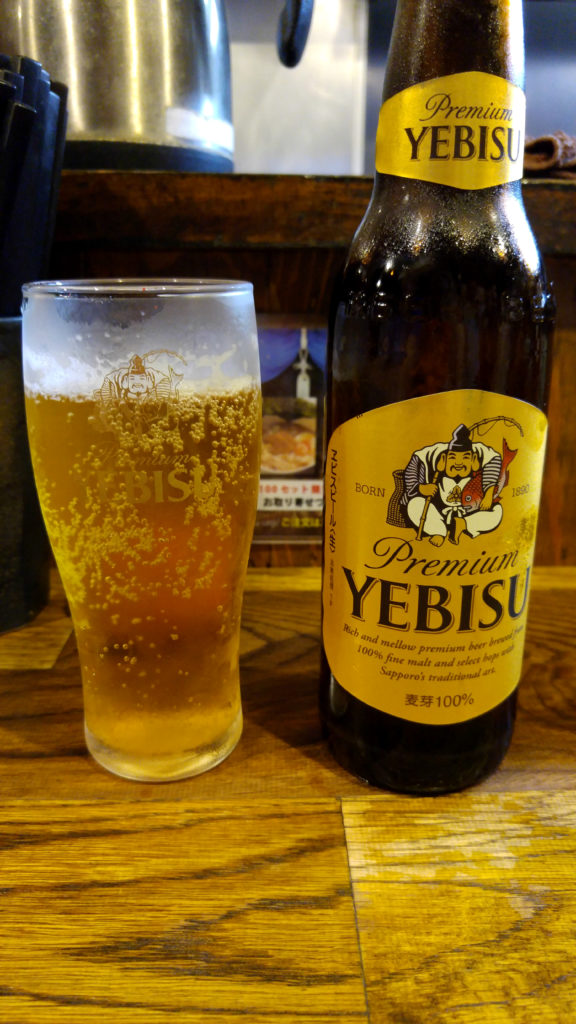Special Tsukemen with Extra Chashu Pork at Fuunji Restaurant in Shinjuku, Tokyo
Despite howling winds and lashing rain from an approaching typhoon, Corey and I braved the streets of Shinjuku in search of a delicious meal. It was our second night in Japan and we couldn’t let two days go by without having any noodles!
Originally, we’d planned to eat soba in memory lane our first night in Tokyo at Kameya Shinjuku, but that had been thwarted by the Obon holiday. So we weren’t going to let the weather stop us from eating at Fuunji!
Finding Fuunji Restaurant in Shinjuku, Tokyo
Finding restaurants in Japan can be a little tricky for foreigners, both because many don’t have English signs and because there is no logical address system. But with Google Maps and pocket wi-fi, it’s easier to navigate Tokyo. Even so, I highly recommend looking up pictures of the restaurant entrance beforehand, which will give you a visual reference point.
Also pay attention to what level the restaurant is located on; remember, Tokyo not only has buildings aboveground, but there are huge sections of the city lurking beneath the surface. Luckily, the GPS coordinates were spot on for Fuunji and we had no trouble locating it.
Fuunji Ramen Vending Machine – Placing Your Order
The Japanese love vending machines! They have vending machines for beer, cigarettes, a wide assortment of non-alcoholic beverages, and even in ramen shops! The first thing you do when you arrive at Fuunji is place your order at a vending machine, which dispenses paper food and drink tickets. You then hand these to the cooks when it’s your turn to sit at the ramen bar. Luckily, the vending machine has English too.
Fuunji serves two main dishes, ramen and tsukemen, which is a special kind of dipping ramen with separate noodles and broth. The noodles are served cold, while the broth and toppings are served piping hot in a bowl. The broth is highly concentrated, thick, creamy, and salty. To eat tsukemen, you pick up some noodles with your chopsticks, dip them into the concentrated broth, and slurp them up (slurping is not only considered polite, but it contributes to the flavor and cools the broth).
The interior of Fuunji consist of an L-shaped ramen bar that’s usually full to capacity with hungry diners, while other guests stand behind them waiting their turn to eat. Because of the bad weather, Corey and I didn’t have to wait long; however, the few minutes we did wait were somewhat awkward because we felt like we were rushing the diners. But when in Rome . . . it’s probably just a cultural difference from the States.
Premium Yebisu All-Malt Beer at Fuunji Restaurant
Fuunji is most known for its tsukemen, but you have to pair it with some beer. You don’t get to pick the kind of beer you want at the vending machine; rather, you just select beer and they bring you whatever they have. It happened to be Yebisu—a premium all-malt beer made by Sapporo Breweries Ltd. Yebisu is a light lager that tastes smooth and refreshing, and was perfect for what had been a hot day.
Special Tsukemen with Extra Chashu Pork at Fuunji Restaurant
When you turn in your food tickets, the staff asks you if you want a medium or large bowl. This refers to the quantity of noodles, and there’s no difference in price between the two. I opted for the medium (pictured above), while Corey ordered the large. As you can see the portion size is very generous; though Corey finished his, I think next time he would order a medium too.
The special tsukemen we ordered came with bamboo shoots, a marinated boiled egg, nori (dried seaweed), and chashu (braised pork belly). The brown powder in the center of the dish is gyofun, a dried fish powder usually made from mackerel. The special tsukemen comes with all of these ingredients, but you can also add other ingredients at the vending machine. I didn’t know this when I placed my order, so that’s why there’s extra chashu with my noodles.
The tsukemen broth is the true delight of the meal. It’s highly concentrated, so each bite bursts with flavor. The fish powder adds a seafood and umami taste to the rich broth. The fresh noodles have a nice al dente texture and are substantial enough to absorb the delicious broth without losing shape.
Note: Tsukemen is very salty. If you don’t like salty foods, this dish is not for you. I think the salt level works well, because you’re just dipping the noodles into the broth and then slurping them up, as opposed to spooning up broth. Once you finish all the noodles, you may dilute the broth with hot-water pitchers that are on the counter and drink it (like the locals do).
When we left Fuunji, the rain and wind had intensified. We only had one umbrella to share. But then a server came out and handed us an umbrella! We assumed she had brought it to us thinking we had left it in the restaurant, so we told her it wasn’t ours. She replied that it was for us to have because of the weather. We accepted with many thanks, surprised by the generosity and hospitality of the Japanese people.
Info about Eating at Fuunji
Hours: Monday – Saturday – 11 AM – 3 PM, 5 PM – 9 PM Sunday – Closed
Address: Yoyogi, Shibuya 151-0053, Tokyo Prefecture
Website: http://www.fu-unji.com/
Phone: +81 3-6413-8480
Notes: No reservations. Cash only.
General Restaurant Tips for Dining in Japan:
- Always call beforehand (or have your hotel call for you) to make sure the restaurant you’re planning to visit is actually open. Several restaurants we visited were closed during the hours listed on their website or Google. So it’s better to double check, especially if the restaurant is far away.
- Look up a picture of the entrance and the floor level beforehand.
- If GPS leads you astray, don’t be afraid to ask a local. We had the hardest time finding Haffu in Kyoto (GPS was WAY off), but when we asked a bicycle delivery guy, he showed us the way.
- Arrive at least 30 minutes prior to close. In the States, you can order right up to close (though the staff might not like it). However, most Japanese restaurants won’t even seat you within 30 minutes of closing. We arrived at a restaurant with a closing time of 10 PM at 9:32 PM, and they turned us away with people still inside.
- If you want to eat at an expensive restaurant but don’t want to pay full freight, check to see if they serve lunch. It’s usually similar food for a much better price.
- Don’t tip. Being a former waitress, this feels wrong. But tipping at restaurants is simply not done in Japan, so be prepared to be chased down if you try.
- Be open to new experiences. Part of the fun of traveling is trying new things and experiencing other cultures. Be adventurous. You don’t know if you’ll like something until you try it!
- Take an umbrella wherever you go. (Though I’ll admit it was probably unusual that 5 typhoons hit during our two and a half week trip.)
- Eat like a local. When eating at Fuunji, we learned to dilute the broth of the tsukemen at the end of the meal and drink it by watching the diners around us.
- Never pour your own drink. We learned this our first night in memory lane when drinking with locals. You should always have someone else refill your glass and then return the favor by pouring theirs.
If you enjoyed reading this post, like my Facebook page and subscribe to my blog to follow my cooking adventures and flavorful journeys!







Pingback: How to Make Chashu (Marinated Braised Pork Belly)
Pingback: Visit Tsukiji Market and Eat Fresh Sushi at Iwasa Sushi